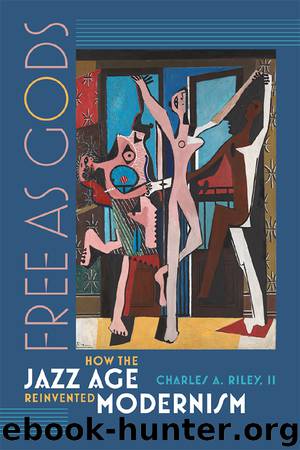Free as Gods by Riley Charles A.;

Author:Riley, Charles A.;
Language: eng
Format: epub
Publisher: University Press of New England
Léger spent the latter part of 1917 and the spring of 1918 in and out of hospitals recovering from the effects of mustard gas. When it came time for him to exhibit his work again in Paris, he was still classified a cubist by dealers and collectors, but now with a difference. According to Christopher Green, “paradoxically, Léger’s anti-harmonious art was invited into the very center of the crystal cubist circle immediately on his return to his Montparnasse studio from hospital, which had occurred by 1 July 1918 when he signed a contract with Rosenberg. In February 1918 it was at Rosenberg’s gallery that he was given his first post-war exhibition, so that he became, in a real sense, an aesthetic saboteur working from within—his intended victim being the Cubist good taste of his own sponsor, Léonce Rosenberg.”3
Just as Le Corbusier and Amédée Ozenfant had launched purism with a repudiation of cubism, Léger devised a new idiom for his période mécanique that broke with Picasso and Braque, veering closer to the machine aesthetic of the purists. They were some of the reliable sources of career support for Léger (in 1920 Le Corbusier started cutting him in on mural commissions and showcased his painting in the landmark pavilion at the International Exposition in 1925), along with Americans including Hemingway and Ezra Pound, who lived on the Rue Notre-Dame-des-Champs near Léger’s studio, and Gerald Murphy, who became a trusted friend. Thanks to Katherine Dreier, an American collector, he had his first exhibition of a dozen paintings in New York in 1924, and by the time the Guggenheim Museum was ready to display nonobjective art in 1939, including his pivotal work Contrast of Forms (1913), he was already a familiar name in art circles from Manhattan to San Francisco.
Le Corbusier devised the “marriage of contours,”4 but Léger took as his early compositional principle the “contrast of forms” (the original 1913 compositions featured disks in primary colors or black against white) and developed an ever-more complex vocabulary inspired by machinery and the city. He was not the only artist in Paris to limit the palette to primary colors. Piet Mondrian had returned from Holland in mid-1919, and in the next year he had painted the first neoplastic painting, a black-and-white grid with red, yellow, and blue panels. The reduction of the palette to primaries was part of the program of the De Stijl group, headed by Theo van Doesburg and including not just Mondrian but the Hungarian Vilmos Huszár; the Belgian sculptor Georges Vantongerloo; and the Belgian architects Gerrit Rietveld, Jacobus Oud (known as J. P. P. Oud), Jan Wils, and Robert van ‘t Hoff. Their furniture, interiors, and paintings all confined themselves to geometric essentials and the basic triad of red, yellow, and blue. The Russian suprematists, for their part, favored the further limitation of the palette to red and black on a pure white ground.
Léger’s writings from the period are certainly on the same page as Le Corbusier’s, as in this essay
Download
This site does not store any files on its server. We only index and link to content provided by other sites. Please contact the content providers to delete copyright contents if any and email us, we'll remove relevant links or contents immediately.
Ancient Worlds by Michael Scott(2492)
Savage Harvest by Carl Hoffman(1865)
The Monuments Men by Robert M. Edsel(1688)
Cain by Jose Saramago(1440)
The Apogee - Byzantium 02 by John Julius Norwich(1367)
A History of the World in 100 Objects by MacGregor Neil(1242)
The O. Henry Prize Stories 2014 by Laura Furman(1183)
The Swerve by Greenblatt Stephen(1091)
The Unfinished Palazzo by Judith Mackrell(1079)
The Lost Secrets of Maya Technology by James A. O'Kon(1056)
50 Art Ideas You Really Need to Know by Susie Hodge(1023)
4 3 2 1 by Paul Auster(989)
Cain by Saramago José(968)
Joan Miró by Joan Miró(963)
A Piece of the World by Christina Baker Kline(962)
Heretics and Heroes by Thomas Cahill(949)
Raising Hell: A Concise History of the Black Arts and Those Who Dared to Practice Them by Robert Masello(922)
The Book of Ruby(896)
1484244826 by Unknown(863)
